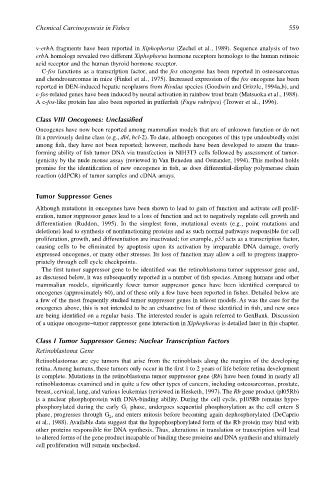Page 579 - The Toxicology of Fishes
P. 579
Chemical Carcinogenesis in Fishes 559
v-erbA fragments have been reported in Xiphophorus (Zechel et al., 1989). Sequence analysis of two
erbA homologs revealed two different Xiphophorus hormone receptors homologs to the human retinoic
acid receptor and the human thyroid hormone receptor.
C-fos functions as a transcription factor, and the fos oncogene has been reported in osteosarcomas
and chondrosarcomas in mice (Finkel et al., 1975). Increased expression of the fos oncogene has been
reported in DEN-induced hepatic neoplasms from Rivulus species (Goodwin and Grizzle, 1994a,b), and
c-fos-related genes have been induced by neural activation in rainbow trout brain (Matsuoka et al., 1988).
A c-fos-like protein has also been reported in pufferfish (Fugu rubripes) (Trower et al., 1996).
Class VIII Oncogenes: Unclassified
Oncogenes have now been reported among mammalian models that are of unknown function or do not
fit a previously define class (e.g., dbl, bcl-2). To date, although oncogenes of this type undoubtedly exist
among fish, they have not been reported; however, methods have been developed to assess the trans-
forming ability of fish tumor DNA via transfection in NIH3T3 cells followed by assessment of tumor-
igenicity by the nude mouse assay (reviewed in Van Beneden and Ostrander, 1994). This method holds
promise for the identification of new oncogenes in fish, as does differential-display polymerase chain
reaction (ddPCR) of tumor samples and cDNA arrays.
Tumor Suppressor Genes
Although mutations in oncogenes have been shown to lead to gain of function and activate cell prolif-
eration, tumor suppressor genes lead to a loss of function and act to negatively regulate cell growth and
differentiation (Ruddon, 1995). In the simplest form, mutational events (e.g., point mutations and
deletions) lead to synthesis of nonfunctioning proteins and as such normal pathways responsible for cell
proliferation, growth, and differentiation are inactivated; for example, p53 acts as a transcription factor,
causing cells to be eliminated by apoptosis upon its activation by irreparable DNA damage, overly
expressed oncogenes, or many other stresses. Its loss of function may allow a cell to progress inappro-
priately through cell cycle checkpoints.
The first tumor suppressor gene to be identified was the retinoblastoma tumor suppressor gene and,
as discussed below, it was subsequently reported in a number of fish species. Among humans and other
mammalian models, significantly fewer tumor suppressor genes have been identified compared to
oncogenes (approximately 60), and of these only a few have been reported in fishes. Detailed below are
a few of the most frequently studied tumor suppressor genes in teleost models. As was the case for the
oncogenes above, this is not intended to be an exhaustive list of those identified in fish, and new ones
are being identified on a regular basis. The interested reader is again referred to GenBank. Discussion
of a unique oncogene–tumor suppressor gene interaction in Xiphophorus is detailed later in this chapter.
Class I Tumor Suppressor Genes: Nuclear Transcription Factors
Retinoblastoma Gene
Retinoblastomas are eye tumors that arise from the retinoblasts along the margins of the developing
retina. Among humans, these tumors only occur in the first 1 to 2 years of life before retina development
is complete. Mutations in the retinoblastoma tumor suppressor gene (Rb) have been found in nearly all
retinoblastomas examined and in quite a few other types of cancers, including osteosarcomas, prostate,
breast, cervical, lung, and various leukemias (reviewed in Hesketh, 1997). The Rb gene product (pl05Rb)
is a nuclear phosphoprotein with DNA-binding ability. During the cell cycle, p105Rb remains hypo-
phosphorylated during the early G phase, undergoes sequential phosphorylation as the cell enters S
1
phase, progresses through G , and enters mitosis before becoming again dephosphorylated (DeCaprio
2
et al., 1988). Available data suggest that the hypophosphorylated form of the Rb protein may bind with
other proteins responsible for DNA synthesis. Thus, alterations in translation or transcription will lead
to altered forms of the gene product incapable of binding these proteins and DNA synthesis and ultimately
cell proliferation will remain unchecked.

